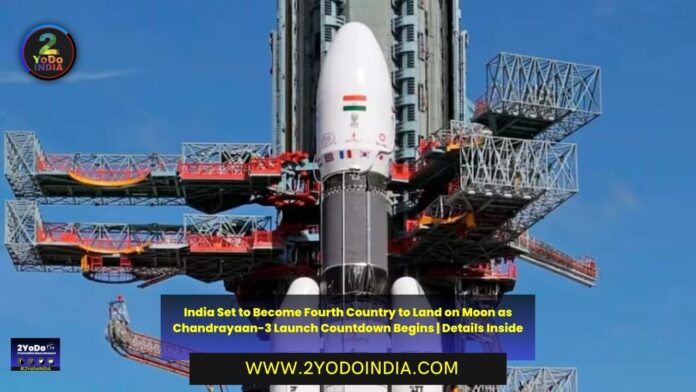Chandrayaan-3, India’s third lunar exploration mission, will make India the fourth country to land its spacecraft on the surface of the moon and demonstrate the country’s abilities for safe and soft landing on lunar surface.
The countdown for the Chandrayaan-3 launch of mission will begin on Thursday ahead of take off on Friday from the Satish Dhawan Space Centre in Sriharikota.
“Mission Readiness Review is completed.
The board has authorise the launch.
The countdown begins tomorrow,” ISRO said in a tweet.
Chandrayaan-3 will be launch on a GSLV Mark 3 (LVM 3) heavy lift launch vehicle.
This will be Indian Space Research Organisation’s (ISRO) follow-up attempt after Chandrayaan-2 mission face challenges during its soft landing in 2019.
The ‘Launch Rehearsal’ simulating the entire launch preparation and process has conclude by the ISRO.
If all goes well, Chandrayaan-3 will be the first spacecraft to land on Moon’s South Pole, demonstrating India’s technical prowess and bold spacefaring ambitions.
Chandrayaan-3 mission will demonstrate safe and soft landing on lunar surface, rover roving on the moon and conduct in-situ scientific experiments.
ISRO invite citizens to witness the launch of the much-awaited Chandrayaan-3 from the viewing gallery at Sriharikota.
During Chandrayaan-2 mission, ISRO lost contact with the lander when it was just a notch away from the moon’s surface.
The journey from earth to the moon for the to-be-launch spacecraft is estimate to take around a month and the landing is expect on 23rd August 2023.
After landing, it will operate for one lunar day, which is approximately 14 earth days.
One day on Moon is equal to 14 days on earth.
K Sivan, former director of ISRO, told that success of mission Chandrayan-3 will give a morale boost to programs like Gaganyan.
K Sivan said :
“We understood what went wrong with Chandrayan-2 when we could not land on the moon surface, we recreated the failure modes and we ensured that this time we have success. The challenge is the same as Chandrayan-2, same environment for landing. This time we hope that we have done enough based on the lesson of Chandrayan-2 that gives us more confidence. In space there are always unknown unknowns…hope that all issues are addressed and that we emerge with success,”.
“We are getting tech landing on a celestial body. By landing successfully, we will acquire landing technology and it will be good for future generations. A number of scientific experiments are planned and scientists will have more knowledge of moon’s geology and earth’s origin,”.
Mylswamy Annadurai, Mission Director of Chandrayaan-1, said Chandrayaan-3 is a very important mission.
Mylswamy Annadurai said :
“We have shown that we can orbit, but we could not do a soft landing, By doing so this time we can show that Chandrayan-1 was not an isolated success. Internationally, the world is looking back to the moon, the real seeding for that came from Chandrayaan-1. So we need to make this mission successful,”.
“Hard lessons were learnt from Chandrayaan 1 and 2. At every step, we are supposed to have a plan B. There were some setbacks in Chandrayaan- 2. This time we are back on track. We are clear on what we want to do and it will ensure we can softly land on the surface of the moon. Target of landing is also larger, all elements have been tested multiple times, we hope this is a success…,”.
Chandrayaan-3’s development phase commence in January 2020 with plans to launch it somewhere in 2021, but the COVID-19 pandemic cause delays in the development process.
The major discovery of the Chandrayaan-1 mission, launch in 2008, is the detection of water (H2O) and hydroxyl (OH) on the lunar surface.
Data also revealed their enhance abundance towards the polar region.
Vikram Sarabhai Space Centre under ISRO had said :
“The primary science objective of the mission was to prepare a three dimensional atlas of both near and far side of the Moon and to conduct chemical and mineralogical mapping of the entire lunar surface with high spatial resolution,”.
Moon serves as a repository of earth’s past and a successful lunar mission by India will help in enhancing life on Earth and prepare to explore the rest of the solar system and beyond.
Director of Indian Space and Research Organisation (ISRO), S Somanath, had said that if everything goes well, the spacecraft will land on the moon on 23rd August 2023.
The date has decide based on sunrise on the moon but if it gets delay, then landing may take place next month, S Somanath said.





